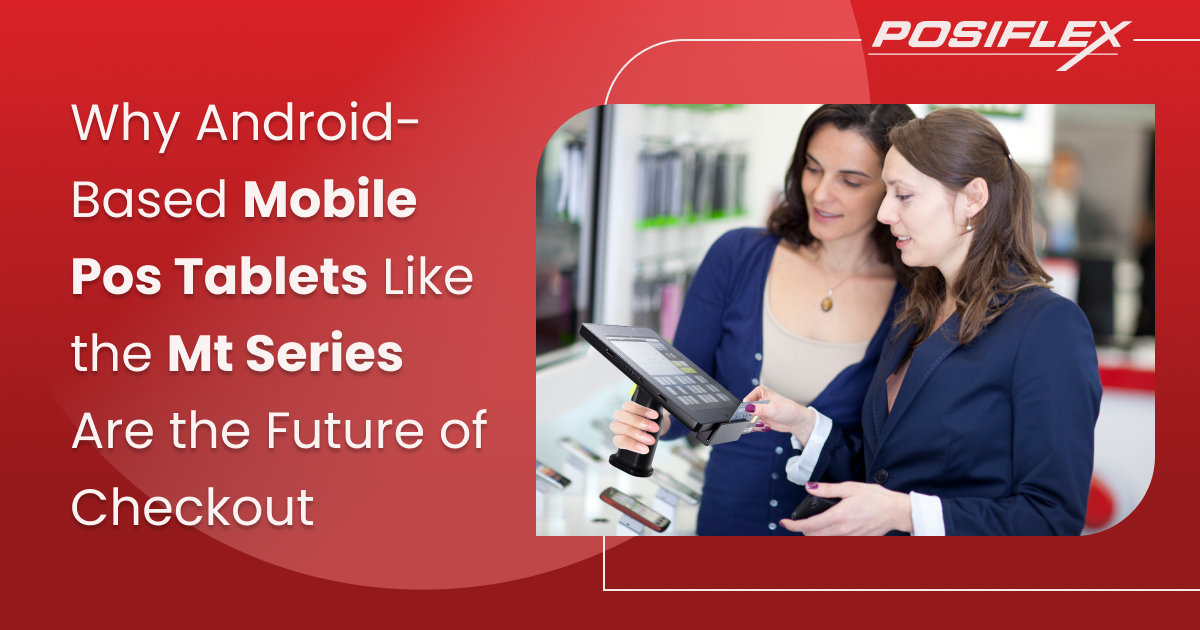
Have you ever wondered what motivates OEMs to manufacture a mid-sized POS device, such as mobile POS tablets, marketed as complementary tools to POS terminals and the typical mobility devices? The answer, in the context of crowd-driven business, is rather straightforward: checkout speed, which is becoming increasingly important by the day across industries.
Let’s dive right in to discover how advanced POS tablets, such as the POSIFLEX MT Series devices, help in crowd management in environments such as restaurants, food courts, retail stores, etc!
The compactness, lightness, and ease of use of mobility devices such as mobile POS tablets make them the perfect queue-busting agents, adding to the speed and portability of the POS ecosystem of operations. Moreover, without causing a space crunch, modern POS tablets operate on robust processors, ensuring that there is no trade-off between device size and efficiency, while in terms of functionality, the integrated designs of the tablets ensure that there is no compromise.
To understand the usefulness of the POS tablets, let’s consider the following scenarios:
It is a peak dining hour or a clearance sale before a major festive period. The cash counters of the food or the retail outlet have long queues. A few executives step out on the operations floor with a mobile POS tablet in their hands, dividing the queues into smaller groups. Given that the tablets come with small accessories or built-in barcode scanners and Magnetic Stripe Readers (MSR), the billing gets over significantly faster than what it would have otherwise taken the cashier.
For retail purchases, the barcode scanner registers the item for billing. On the other hand, in both scenarios, the MSR is used for debit card and credit card payments as well as for loyalty point redemption when a loyalty card is swiped.
Additionally, if the premises have CCTV cameras set at different angles, cash payments can be secure too. As for the receipt generation, the mobile tablets can be connected to a small printer and placed on the restaurant table or a makeshift or infrequently used service counter, where often salespeople show clothes or product demos.
Alongside their lightness, mobile POS tablets from the POSIFLEX MT Series are also compact. The slim tablet structure entails a built-in 2D barcode scanner and a powerful NFC sensor, responsible for robust connectivity features:
The connectivity features, which are among the latest versions in the market, are one of the reasons why payments are swiftly processed.
MT Series can also be combined with side attachments such as MSRs and FPU (Fingerprint Units); the latter prevents unauthorised staff from using the tablet.
Furthermore, the Android POS tablets have 8”, responsive, PCAP-touch displays. The MT series POS displays, being large and quick-to-respond, enhance the user experience, thus fast-tracking the billing process.
In terms of ease of use, the protective cover of the tablet can be attached to both a shoulder and hand strap, making the device fit for prolonged use; the hand strap fits both left-handed and right-handed users.
Industries, such as warehousing, manufacturing, and logistics, where mobility is key for inventory management, billing, and inventory tracking and audits, also require mobility devices like POS tablets. Usually, these businesses would be categorised as mid-sized, if not large-scale enterprises.
In these heavy-duty environments, the need for computational power is also high. Thus, POS boxes can be game-changing.
The processor, storage, RAM, and Operating System of the mobile POS system also play a vital role in determining payment processing speed.
In this scenario, MT Series Android POS tablets run on the efficient MediaTek MT8786 processor. The processor’s RISC ISA variant ensures Android 13 OS with GMS (Google Mobile Services)-compatibility, which is yet another reason why the POSIFLEX mobile POS tablet is not just high-performing but also suitable for the Google services suite.
This means if any billing-related task needs to be performed via the Google services suite, the tablet supports the tasks. One such task, in the context of brands supporting omnichannel retail, could be logging into the web app/ website of the brand to place orders: let’s say, when customers inform during the billing process that a particular item is not available in the size they want. In this way, a post-paid or prepaid order can be placed for pick-up or home delivery.
Influencing billing speed, here are the RAM and storage specifications of Android POS tablets from the MT Series:
On a final note, it is worth noting that the MT Series POS tablets also come in Windows 11 versions. Check out our other blogs on the MT Series and our website to know the details! And, if you have more questions about the Android POS tablets from the MT Series, contact us now—one of our executives will get in touch with you soon!
Copyright © 2025 Posiflex Technology, Inc. All Rights Reserved.
WhatsApp us